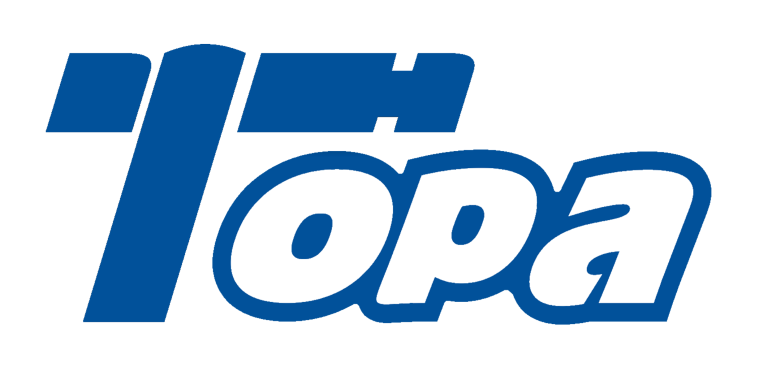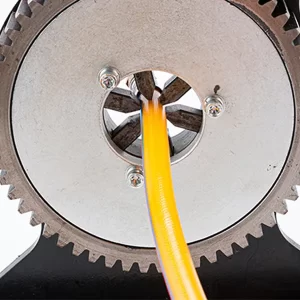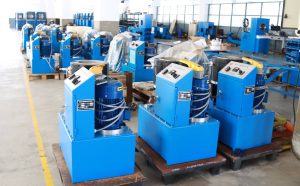Understanding what a hydraulic hose crimper is and how it functions is crucial for businesses relying on hydraulic systems. This article, titled “What Is a Hydraulic Hose Crimper and How Does It Function?”, explores the purpose, mechanics, and significance of these machines in hydraulic hose assembly. But here’s the kicker: hydraulic hose crimpers play a vital role in ensuring secure, leak-free connections essential for safety and performance in many industries. We’ll delve into the types, operation, components, and future developments of these indispensable tools to help you make informed decisions and optimize your operations.
1. What exactly is a hydraulic hose crimper?
A hydraulic hose crimper is a specialized machine designed to attach fittings to hydraulic hoses by compressing a metal sleeve or ferrule securely around the hose end. This process creates a strong, leak-proof connection that can withstand high pressures. Hydraulic hose crimpers come in various types including manual, electric, and fully hydraulic models, each suited for different production volumes and precision requirements. Industries such as construction, agriculture, automotive, and manufacturing rely heavily on crimpers to assemble hoses that power hydraulic systems. Ready for the good part? These machines ensure consistent quality and safety in hydraulic applications, reducing downtime caused by hose failures and leaks.
| Type of Crimper | Application | Advantages |
|---|---|---|
| Manual | Small-scale, low volume | Cost-effective, portable |
| Electric | Medium volume, higher precision | Automation, consistency |
| Hydraulic | High volume, heavy-duty | Power, speed, reliability |
2. How does a hydraulic hose crimper operate?
The operation of a hydraulic hose crimper involves several key steps. Initially, the hose end and fitting are prepared and inserted into the machine’s die set. The crimper uses hydraulic pressure to compress the die around the fitting, deforming it and creating a tight mechanical bond. The hydraulic system relies on a pump to generate pressure, which is transmitted via fluid to actuate a piston or ram that applies force. Proper die selection and pressure settings are critical to achieve a secure crimp without damaging the hose or fitting. What’s the real story? Precision and control in the crimping process ensure the integrity of hydraulic connections, preventing leaks and failures that could lead to costly repairs or accidents.
| Operation Step | Description | Importance |
|---|---|---|
| Preparation | Cut hose and fit components | Ensures clean assembly |
| Die Placement | Positioning in crimper | Critical for correct size |
| Compression | Hydraulic pressure applied | Creates tight, durable bond |
3. What components make up a hydraulic hose crimper?
A typical hydraulic hose crimper comprises several essential components working together seamlessly. The hydraulic pump provides the force needed to drive the piston or ram, which compresses the dies. The die set itself is tailored to specific hose sizes and fitting types, ensuring correct crimp dimensions. Control systems, either manual levers or electronic interfaces, allow operators to regulate pressure and cycle timing. Safety features such as emergency stops and pressure relief valves protect operators from hazards. But here’s the kicker: quality materials and precise engineering of these components ensure reliability and longevity under demanding industrial conditions.
| Component | Function | Key Feature |
|---|---|---|
| Hydraulic Pump | Generates pressure | Consistent force |
| Dies | Shape and size crimp | Customizable for hoses |
| Control System | Operate and regulate crimp | Manual or automated |
4. What are the different types of hydraulic hose crimpers available?
Hydraulic hose crimpers vary in design to suit diverse operational needs. Manual crimpers require physical effort and are ideal for low-volume or field use, offering portability and simplicity. Electric crimpers automate many functions, providing greater precision and faster cycle times, suitable for medium production runs. Fully hydraulic crimpers deliver maximum power and speed, ideal for high-volume industrial manufacturing. Additionally, portable crimpers enable on-site repairs and maintenance, while stationary units focus on factory production. This is where it gets interesting: choosing the right type depends on production demands, hose sizes, and budget considerations, impacting efficiency and product quality.
| Crimper Type | Typical Use | Pros and Cons |
|---|---|---|
| Manual | Small jobs, fieldwork | Low cost, labor intensive |
| Electric | Medium production | Precision, faster operation |
| Hydraulic | Large scale industrial | High power, high throughput |
| Portable | On-site maintenance | Flexibility, mobility |
5. How do you select the right hydraulic hose crimper for your needs?
Selecting the appropriate hydraulic hose crimper requires assessing several critical factors. First, consider the hose sizes and fitting types commonly used in your operations. Production volume dictates whether a manual, electric, or hydraulic crimper suits your needs best. Budget constraints and expected return on investment guide equipment choice. Vendor support, availability of replacement parts, and training services also weigh heavily. Ready for the good part? A thorough evaluation balances upfront costs against long-term efficiency gains and reliability, ensuring your choice maximizes productivity and minimizes downtime.
| Selection Criteria | Key Considerations | Impact on Choice |
|---|---|---|
| Hose Size Range | Compatibility with equipment | Avoids mismatched tools |
| Production Volume | Frequency of use | Determines automation level |
| Budget | Initial and operating costs | ROI and maintenance |
6. What safety features are built into modern hydraulic hose crimpers?
Safety remains paramount in hydraulic hose crimping operations. Modern crimpers incorporate emergency stop buttons, guards, and pressure relief valves to protect operators from injury. Sensors detect obstructions or improper die placement, halting operations automatically. Compliance with safety standards such as OSHA and ISO ensures risk mitigation. Operator training programs emphasize safe practices alongside machinery features. But here’s the kicker: integrating these safety measures reduces workplace accidents and liability, fostering a secure environment conducive to productivity.
| Safety Feature | Purpose | Benefit |
|---|---|---|
| Emergency Stop | Immediate machine halt | Prevents accidents |
| Guards | Physical barrier | Protects operator |
| Sensors | Detect hazards | Auto shutdown |
7. How do hydraulic hose crimpers ensure quality and reliability?
Quality in hydraulic hose crimping depends on precision alignment of dies, consistent pressure application, and thorough maintenance. Machines undergo regular calibration to maintain specifications. Visual and pressure testing verifies crimp integrity, ensuring leak-proof connections. Manufacturers often implement ISO quality management systems. This is where it gets interesting: repeatability and accuracy minimize rework and warranty claims, directly impacting customer satisfaction and operational costs.
| Quality Factor | Quality Assurance Method | Effect |
|---|---|---|
| Die Alignment | Regular calibration | Consistent crimps |
| Pressure Control | Automated regulation | Uniform compression |
| Testing | Visual and pressure testing | Leak prevention |
8. What maintenance practices extend the life of hydraulic hose crimpers?
Routine maintenance is vital for hydraulic hose crimpers’ longevity. Regular lubrication of moving parts reduces wear. Hydraulic fluid must be checked and replaced to maintain system pressure and prevent contamination. Dies require cleaning and inspection for damage. Scheduled preventive maintenance avoids costly breakdowns. Ready for the good part? Proper maintenance not only extends equipment lifespan but also preserves crimping quality and safety, making it a sound investment in operational reliability.
| Maintenance Task | Frequency | Purpose |
|---|---|---|
| Lubrication | Weekly or monthly | Reduces friction |
| Fluid Replacement | Annually or per usage | Maintains pressure |
| Die Inspection | Before each use | Prevents defects |
9. How does automation enhance hydraulic hose crimper performance?
Automation streamlines hydraulic hose crimping, delivering faster cycle times and consistent quality. Automated pressure control systems adjust force precisely for different hose types. Data logging tracks machine usage, maintenance needs, and production output. Integration with factory control systems enables seamless workflow. But here’s the kicker: automation reduces human error, improves throughput, and provides valuable analytics for continuous improvement, key advantages in competitive manufacturing environments.
| Automation Feature | Function | Benefit |
|---|---|---|
| Pressure Control | Automatic adjustment | Precision and consistency |
| Data Logging | Performance tracking | Predictive maintenance |
| System Integration | Workflow synchronization | Improved efficiency |
10. What training is necessary for operators of hydraulic hose crimpers?
Operators require comprehensive training covering machine operation, safety protocols, troubleshooting, and maintenance. Hands-on training combined with theory ensures competency. Virtual reality (VR) tools increasingly supplement traditional methods, offering immersive scenarios. Certified programs enhance credibility and safety compliance. Ready for the good part? Skilled operators reduce errors and downtime, elevating overall productivity and safeguarding investments.
| Training Type | Method | Outcome |
|---|---|---|
| Hands-on | Practical machine use | Operator competence |
| VR Simulation | Immersive learning | Safe skill acquisition |
| Certification | Formal assessment | Compliance and confidence |
11. How do hydraulic hose crimpers fit into overall hydraulic system assembly?
Hydraulic hose crimpers are crucial in hose assembly, connecting hoses to fittings that transfer fluids under pressure. Proper crimping ensures leak-free connections essential for system performance and safety. Crimpers work alongside hose cutters, testers, and cleaners in production lines. Compatibility with various hose and fitting types supports system customization. What’s the real story? The crimper’s role directly affects the reliability and longevity of hydraulic systems, making it a cornerstone of hydraulic assembly.
| Assembly Component | Function | Relation to Crimping |
|---|---|---|
| Hose Cutter | Cuts hoses to length | Prepares hose ends |
| Hose Cleaner | Removes contaminants | Ensures clean assembly |
| Pressure Tester | Verifies integrity | Confirms crimp quality |
12. What innovations are shaping the future of hydraulic hose crimpers?
The future of hydraulic hose crimpers includes smart sensors for real-time monitoring, AI-driven automation optimizing crimping parameters, and environmentally conscious designs focusing on energy efficiency. Additive manufacturing allows rapid prototyping of customized parts. Blockchain technology promises enhanced traceability in supply chains. But here’s the kicker: these innovations improve productivity, reduce waste, and enhance safety, positioning the industry for sustainable growth and adaptability.
| Innovation | Description | Benefit |
|---|---|---|
| Smart Sensors | Real-time monitoring | Proactive maintenance |
| AI Automation | Adaptive crimping control | Enhanced quality |
| Eco-Design | Energy-saving technologies | Lower operational costs |
13. How do hydraulic hose crimpers contribute to workplace safety?
By automating strenuous manual tasks, hydraulic hose crimpers reduce operator fatigue and injury risks. Secure crimps prevent hose failures that could cause leaks or bursts, protecting workers. Built-in safety features like emergency stops and guards further mitigate hazards. Ready for the good part? Compliance with safety standards ensures legal adherence and fosters a safety-first culture, crucial for workforce well-being and operational continuity.
| Safety Aspect | Benefit | Workplace Impact |
|---|---|---|
| Automation | Reduced manual strain | Lower injury rates |
| Secure Connections | Leak and burst prevention | Enhanced safety |
| Safety Features | Operator protection | Accident reduction |
14. What are the common troubleshooting steps for hydraulic hose crimpers?
Troubleshooting often begins with checking hydraulic fluid levels and pressure settings. Misaligned dies can cause uneven crimps and must be realigned. Inspecting for leaks in hoses and seals is essential. Electrical issues like faulty switches or sensors require testing. What’s the real story? Regular maintenance paired with proper troubleshooting minimizes downtime and maintains consistent quality, preserving production efficiency.
| Issue | Possible Cause | Troubleshooting Step |
|---|---|---|
| Low pressure | Hydraulic fluid low | Refill or check for leaks |
| Uneven crimp | Die misalignment | Realign dies |
| Sensor failure | Electrical fault | Inspect wiring and sensors |
15. How can businesses maximize the ROI of hydraulic hose crimpers?
Maximizing ROI involves selecting the right equipment tailored to production needs, investing in thorough operator training, and adhering to regular maintenance schedules. Leveraging automation and software integration enhances productivity and reduces waste. Analyzing production data helps identify improvement areas. But here’s the kicker: strategic investment coupled with ongoing optimization drives long-term cost savings and competitive advantage, turning hydraulic hose crimpers into profit centers.
| Strategy | Action | ROI Impact |
|---|---|---|
| Right Equipment | Needs-based selection | Reduced operational costs |
| Training | Comprehensive programs | Fewer errors, higher uptime |
| Maintenance | Scheduled servicing | Extended equipment life |
FAQ Section
Q1: What is a hydraulic hose crimper?
A hydraulic hose crimper is a machine that secures fittings onto hoses by compressing metal sleeves, creating tight, leak-proof connections essential for hydraulic systems.
Q2: How does a hydraulic hose crimper work?
It uses hydraulic pressure to force dies around hose fittings, deforming the metal to form a secure mechanical bond.
Q3: What types of hydraulic hose crimpers exist?
Manual, electric, hydraulic-powered, portable, and stationary models designed for different volumes and applications.
Q4: What safety features are common in hydraulic hose crimpers?
Emergency stops, protective guards, pressure relief valves, and operator presence sensors ensure safe operation.
Q5: How important is operator training for using hydraulic hose crimpers?
Proper training improves safety, reduces errors, ensures quality crimps, and prolongs machine lifespan.




